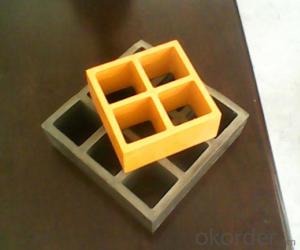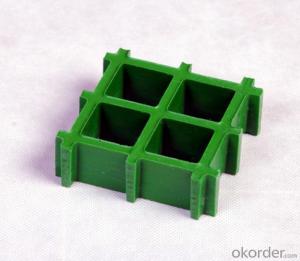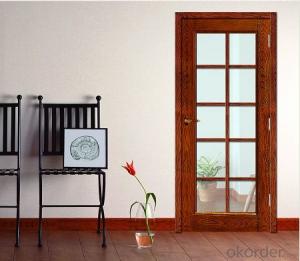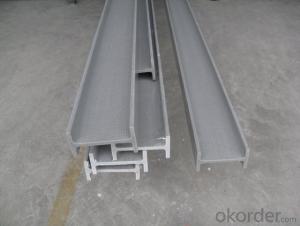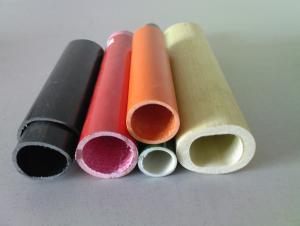FRP Pultrusion Profiles - Reinforce Fiber Glass Rebar
- Loading Port:
- Shanghai
- Payment Terms:
- TT or LC
- Min Order Qty:
- -
- Supply Capability:
- 50000 m.t./month
OKorder Service Pledge
OKorder Financial Service
You Might Also Like
1.Brief Introduction
GFRP Rebar,FRP Rebar,GRP Rebar,glass fiber reinforced polymer rebar,low-weight rebar,all-thread rebar,anti-static rebar.
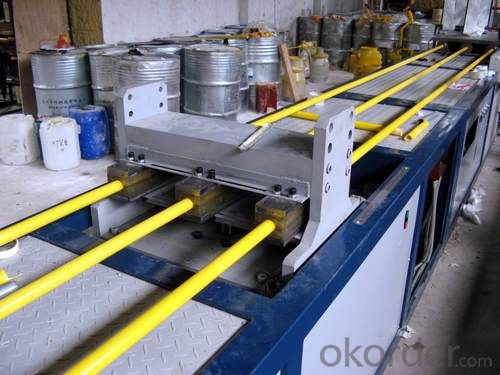
2.Characteristics
(1)All-Thread FRP Bolt: The rod is threaded over the whole length, i.e. "All-Thread";
(2)High Corrosion Resistance: The base materials used by the bolt are durable materials, and they are molded through the composite process. The life span is up to 100 years. They can be used as permanent support materials;
(3)High Tensile Strength: The load is approximately double that of a steel bar with the same diameter;
(4)Low Weight: The weight is only 1/4 that of a steel bar with the same diameter. Therefore, the labor intensity is greatly reduced, and the transportation cost is reduced at the same time;
(5)Anti-static: It has no electrical conductivity, and no sparks will be produced when being cut. It is particularly suitable for high gas zones;
(6)Non-flammable: It is non-flammable and has high thermal isolation;
(7)Cuttability: It avoids damages to cutter heads, and does not delay excavation;
3.Application
| GFRP Rebar Technical Data (General) | ||||||||||||||||||
| Diameter(mm) | 3 | 4 | 6 | 8 | 10 | 12 | 14 | 16 | 18 | 20 | 22 | 25 | 28 | 30 | 32 | 34 | 36 | 40 |
| Cross section(mm2) | 7 | 12 | 28 | 50 | 73 | 103 | 134 | 180 | 248 | 278 | 355 | 478 | 590 | 671 | 740 | 857 | 961 | 1190 |
| Density(g/cm3) | 2.2 | 2.2 | 2.2 | 2.2 | 2.2 | 2.1 | 2.1 | 2.1 | 2.1 | 2.1 | 2.1 | 2.1 | 2.1 | 2.1 | 2.1 | 2.1 | 2.1 | 2.1 |
| Weight(g/m) | 18 | 32 | 51 | 98 | 150 | 210 | 275 | 388 | 485 | 570 | 700 | 970 | 1195 | 1350 | 1520 | 1800 | 2044 | 2380 |
| Ultimate tensile(KN) | 13.5 | 18 | 36 | 54 | 72 | 99 | 117 | 149 | 189 | 225 | 270 | 342 | 432 | 450 | 504 | 540 | 585 | 640 |
| Ultimate tensilestrength(Mpa) | 1900 | 1500 | 1280 | 1080 | 980 | 870 | 764 | 752 | 744 | 716 | 695 | 675 | 702 | 637 | 626 | 595 | 575 | 509 |
| Ultimate shear strength(Mpa) | >150 | >150 | >150 | >150 | >150 | >150 | >150 | >150 | >150 | >150 | >150 | >150 | >150 | >150 | >150 | >150 | >150 | >150 |
| E-modulus(GPa) | >40 | >40 | >40 | >40 | >40 | >40 | >40 | >40 | >40 | >40 | >40 | >40 | >40 | >40 | >40 | >40 | >40 | >40 |
4.FAQ
Such as,construction, transportation industry,electrical industry and communication engineering,which are coal mine tunnel,parking structures, half coal roadway, slope support, subway tunnel,rock surface anchoring, sea wall and dam etc.
FRP rebar applied in the coal mine:
Used for the anchor bolt to fix the guard or rail, good resistance to the corrosion.
FRP rebar applied in the transportation area:
Used for the road, bridge construction, due to good strength and corrosion resistance.
FRP rebar applied in road construction:
Used for the road, bridge construction, due to good strength and corrosion resistance.
FRP rebar applied in underground structure:
Used for the underground structure, due to good strength and corrosion resistance.
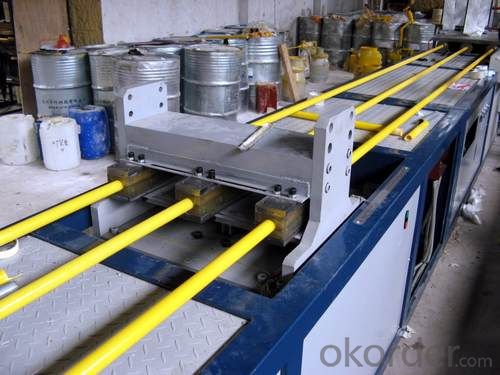
- Q: How do FRP pultrusion profiles perform in high-vibration applications?
- High-vibration applications are where FRP (Fiber Reinforced Polymer) pultrusion profiles truly excel. The exceptional properties of FRP materials make them an ideal choice for these situations. To begin with, FRP pultrusion profiles are renowned for their impressive strength-to-weight ratio. Unlike traditional materials like steel or aluminum, FRP profiles are significantly lighter while still possessing remarkable strength and rigidity. This lightweight quality reduces the overall mass of the structure, resulting in lower vibration amplitudes. Furthermore, FRP materials boast outstanding damping characteristics. Damping refers to a material's ability to dissipate energy and decrease vibration amplitudes. In comparison to other materials, FRP pultrusion profiles have a higher damping coefficient, meaning they can more effectively absorb and dissipate vibrations. This minimizes the transmission of vibrations throughout the structure, reducing the risk of resonance and fatigue failure. In addition, FRP pultrusion profiles demonstrate exceptional resistance to fatigue and corrosion. Vibrations can cause cyclic loading, which can lead to fatigue failure over time. However, the inherent properties of FRP materials, including their excellent tensile strength and resistance to environmental factors, make them highly resilient to fatigue and corrosion. This guarantees the longevity and durability of the profiles, even in high-vibration environments. Moreover, FRP pultrusion profiles offer immense design flexibility, allowing for customized shapes and sizes that can be tailored to specific applications. This flexibility allows engineers to optimize the profiles' performance in high-vibration scenarios by adjusting the geometry and composition to enhance their dynamic characteristics. In summary, FRP pultrusion profiles are exceptionally suited for high-vibration applications due to their lightweight nature, excellent damping characteristics, resistance to fatigue and corrosion, and design flexibility. These profiles provide a reliable and durable solution that can effectively withstand the challenges posed by vibrations, ensuring safe and efficient operation in such environments.
- Q: Are FRP pultrusion profiles resistant to caustic solutions?
- FRP pultrusion profiles are known for their resistance to caustic solutions. The combination of reinforcing fibers and the polymer matrix used in FRP pultrusion provides exceptional chemical resistance. Unlike traditional materials like steel or wood, which can be corroded or degraded by strong alkaline substances, FRP pultrusion profiles are highly resistant to chemical attack. This makes them suitable for industries that frequently encounter caustic solutions, such as chemical processing, wastewater treatment, and marine environments. However, it is important to refer to the manufacturer's specifications and guidelines to ensure compatibility between specific caustic solutions and the chosen FRP pultrusion profile.
- Q: Are FRP pultrusion profiles suitable for the manufacturing of antenna masts?
- Yes, FRP pultrusion profiles are suitable for the manufacturing of antenna masts. FRP pultrusion profiles offer several advantages such as high strength-to-weight ratio, corrosion resistance, and excellent electrical insulation properties. These characteristics make them ideal for antenna mast construction, as they can withstand various environmental conditions and provide reliable support for antennas.
- Q: What is the fatigue resistance of FRP pultrusion profiles?
- FRP pultrusion profiles possess excellent fatigue resistance, allowing them to withstand repeated or cyclic loading without experiencing failure or degradation over time. When compared to traditional materials like steel or aluminum, FRP profiles are known for their exceptional fatigue resistance. The fatigue resistance of FRP pultrusion profiles can be attributed to the composite material itself. FRP profiles are typically made by impregnating continuous fibers, such as fiberglass or carbon fiber, with a polymer resin matrix. This combination of fibers and resin creates a material with a high strength-to-weight ratio, excellent corrosion resistance, and superior fatigue properties. The inherent resistance against fatigue in FRP profiles is due to the fiber reinforcement. The continuous fibers distribute and absorb stresses more evenly, preventing the formation and propagation of cracks or defects that can lead to failure. Additionally, the polymer resin matrix acts as a protective layer, safeguarding the embedded fibers from environmental factors that could degrade their fatigue resistance. To further enhance the fatigue resistance of FRP pultrusion profiles, specific design considerations and manufacturing techniques can be employed. Optimizing the orientation and arrangement of the fibers within the profile can improve the load-carrying capacity and fatigue life. Advanced resin systems and manufacturing processes can also result in improved bonding between the fibers and the matrix, further enhancing fatigue resistance. Overall, FRP pultrusion profiles are widely acclaimed for their exceptional fatigue resistance. This makes them an ideal choice for applications requiring long-term durability and resistance to cyclic loading, such as infrastructure components, aerospace structures, marine applications, and sporting goods.
- Q: What is the cost of FRP pultrusion profiles compared to other materials?
- The cost of FRP (Fiber Reinforced Polymer) pultrusion profiles can vary depending on several factors such as the specific application, size, complexity of design, and quantity required. However, in general, FRP pultrusion profiles tend to be more cost-effective compared to many traditional materials. When compared to materials like steel, aluminum, or wood, FRP pultrusion profiles often provide a lower overall cost, especially when considering long-term savings. While the initial material cost of FRP pultrusion profiles may be slightly higher than some traditional materials, the benefits and advantages it offers can outweigh the price difference. FRP pultrusion profiles are known for their lightweight nature, high strength-to-weight ratio, corrosion resistance, and durability. These characteristics contribute to reducing transportation costs, installation expenses, and maintenance requirements. Additionally, the long lifespan of FRP profiles ensures minimal replacement or repair costs over time. Moreover, the manufacturing process of FRP pultrusion profiles allows for precise customization, eliminating the need for additional machining or fabrication, which can further reduce costs. The ability to incorporate design features such as integral stiffeners, brackets, and fastening points during the pultrusion process eliminates the need for additional assembly steps, ultimately saving time and money. It is important to note that while FRP pultrusion profiles may have a higher upfront cost compared to some materials, the overall cost-effectiveness and long-term benefits make them a favorable choice in many applications. Each project's specific requirements and considerations should be taken into account when evaluating the cost of FRP pultrusion profiles compared to other materials.
- Q: Can FRP pultrusion profiles be customized or tailored to specific project requirements?
- Yes, FRP (Fiber Reinforced Polymer) pultrusion profiles can be customized or tailored to specific project requirements. Pultrusion is a manufacturing process that allows for the creation of continuous fiber-reinforced composite profiles with a high level of design flexibility. The specific requirements of a project, such as dimensions, shapes, and mechanical properties, can be accommodated by adjusting the design and manufacturing parameters. The customization process begins with understanding the project's needs and specifications. This includes determining the desired profile dimensions, cross-sectional shape, and mechanical properties such as strength, stiffness, and durability. Based on these requirements, engineers and manufacturers can develop a tailored solution. The customization of FRP pultrusion profiles can be achieved through various means. Firstly, the choice of reinforcement materials, such as fiberglass, carbon fiber, or aramid fiber, can be selected based on the desired mechanical characteristics. The orientation and volume fraction of the fibers can also be adjusted to optimize the strength and stiffness of the profile. Additionally, the resin matrix used in the pultrusion process can be customized to enhance specific properties, such as fire resistance, chemical resistance, or UV resistance. Various resin systems, including polyester, vinyl ester, or epoxy, can be utilized to meet the project's requirements. Furthermore, the pultrusion process allows for the incorporation of additional features during manufacturing. This includes adding inserts, fastener holes, grooves, or other structural details to the profile. These modifications can be tailored to the specific project requirements, ensuring compatibility with the overall design and assembly. Overall, FRP pultrusion profiles offer a high degree of customization and tailoring to meet specific project requirements. This versatility makes them a popular choice in various industries, including construction, infrastructure, aerospace, and automotive, where lightweight, durable, and corrosion-resistant materials are needed.
- Q: Are FRP pultrusion profiles resistant to vibration or shock?
- FRP pultrusion profiles exhibit high resistance to both vibration and shock. Their exceptional properties, inherent in FRP materials, make them an ideal choice for applications that demand durability and strength in the face of dynamic loading conditions. The composition of FRP profiles typically entails a combination of reinforcing fibers and a resin matrix, resulting in superb stiffness and damping characteristics. As a result, FRP pultrusion profiles effectively absorb and dissipate vibrations and shock forces, effectively preventing damage or degradation. Moreover, the design flexibility of FRP enables tailored reinforcement and optimization, further bolstering their ability to withstand vibration and shock. Consequently, FRP pultrusion profiles prove to be a dependable option for industries such as aerospace, automotive, marine, and structural engineering, where these properties are of utmost importance.
- Q: Can FRP pultrusion profiles be used in the telecommunications and data communication industry?
- Indeed, the telecommunications and data communication industry can utilize FRP (Fiber Reinforced Plastic) pultrusion profiles. These profiles possess numerous advantages that render them appropriate for incorporation in this particular sector. First and foremost, FRP pultrusion profiles exhibit exceptional electrical insulation properties, rendering them perfect for applications in the telecommunications and data communication industry where minimizing electrical conductivity is imperative. FRP profiles do not conduct electricity, thereby ensuring the absence of interference or grounding issues that could potentially disrupt data transmission. Secondly, FRP pultrusion profiles are both lightweight and robust, resulting in a high strength-to-weight ratio. This characteristic makes them well-suited for the construction of communication towers, antenna supports, and satellite dish mountings. In these applications, the profiles must withstand environmental stresses such as wind loads. Moreover, FRP profiles exhibit outstanding corrosion resistance, a crucial attribute in the telecommunications and data communication industry where equipment is frequently exposed to harsh outdoor environments. Unlike traditional materials like steel or aluminum, FRP profiles do not rust or corrode, thereby guaranteeing the longevity and reliability of the infrastructure. Furthermore, FRP profiles can be easily customized and manufactured in various shapes and sizes to meet the precise requirements of telecommunications and data communication applications. This flexibility enables the design and construction of intricate structures capable of accommodating different equipment and technologies. In summary, FRP pultrusion profiles provide a multitude of advantages that render them highly suitable for application in the telecommunications and data communication industry. Their electrical insulation properties, lightweight yet strong nature, corrosion resistance, and design flexibility make them a dependable choice for supporting infrastructure in this sector.
- Q: Are pultruded FRP sections strong? What are its main areas of application?
- The tensile strength of products produced by pultrusion process is higher than that of ordinary steel.Widely used in transportation, electrical, electrical, electrical insulation, chemical, mining, marine, watercraft, corrosive environment and life, civil areas.
- Q: Do FRP pultrusion profiles require regular maintenance?
- FRP pultrusion profiles do not require regular maintenance. One of the key advantages of FRP (Fiber Reinforced Polymer) is its durability and low maintenance requirements. Unlike traditional materials like wood or steel, FRP does not corrode, rust, or degrade over time. This means that FRP pultrusion profiles do not need to be painted, sealed, or treated for protection against environmental factors such as moisture, UV radiation, or chemicals. Furthermore, FRP is resistant to a wide range of chemicals, making it suitable for various industries, including marine, chemical processing, and wastewater treatment. It also has excellent dimensional stability, meaning it does not warp or deform under changing temperatures or humidity levels. While FRP pultrusion profiles may not require regular maintenance, it is still important to inspect them periodically to ensure their structural integrity. This can involve visual inspections for any signs of damage, such as cracks, delamination, or wear. Additionally, cleaning the profiles with mild soap and water can help remove any surface dirt or contaminants. Overall, FRP pultrusion profiles offer a long-lasting and low-maintenance solution for many applications, making them a cost-effective choice in the long run.
Send your message to us
FRP Pultrusion Profiles - Reinforce Fiber Glass Rebar
- Loading Port:
- Shanghai
- Payment Terms:
- TT or LC
- Min Order Qty:
- -
- Supply Capability:
- 50000 m.t./month
OKorder Service Pledge
OKorder Financial Service
Similar products
Hot products
Hot Searches
Related keywords
















